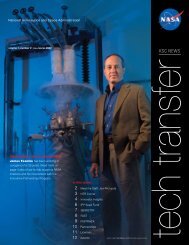2006-2007 - Kennedy Space Center Technology Transfer Office
2006-2007 - Kennedy Space Center Technology Transfer Office
2006-2007 - Kennedy Space Center Technology Transfer Office
- No tags were found...
Create successful ePaper yourself
Turn your PDF publications into a flip-book with our unique Google optimized e-Paper software.
Tribocharging Lunar Soil for Electrostatic Beneficiation<strong>2006</strong> <strong>Center</strong> Director’s Discretionary Fund ProjectFuture human lunar habitation requires using in situ materials for both structuralIn Situ ResourceUtilization (ISRU) components and oxygen production. Lunar bases must be constructed from thermal-Oxygen Production and radiation-shielding materials that will provide significant protection from theharmful cosmic energy which normally bombards the lunar surface. In addition,shipping oxygen from Earth is weight-prohibitive, and therefore investigating the production ofbreathable oxygen from oxidized mineral components is a major ongoing NASA research initiative.Lunar regolith may meet the needs for both structural protection and oxygen production. Alreadya number of oxygen production technologies are being tested, and full-scale bricks made of lunarstimulant have been sintered. The beneficiation, or separation, of lunar minerals into a refinedindustrial feedstock could make production processes more efficient, requiring less energy to operateand maintain and producing higher-performance end products.The method of electrostatic beneficiation used in this research charges mineral powders (lunarsimulant) by contact with materials of a different composition. The simulant acquires either apositive or negative charge depending upon its composition relative to the charging material. Thecharged particles can then undergo electrostatic separation in an electric field based upon theircharge-to-mass ratio (Q/M). Characteristics such as bulk, surface composition, and particle sizeinfluence the ability of the material to garner a charge and separate under the influence of theelectric field. The lunar regolith grains and the lunar environment are ideal for triboelectrificationand electrostatic separation because the lack of moisture prevents the grains from sticking togetherand the lower gravitational pull permits longer contact times during charging and increased particleseparation.After successful beneficiation experiments had shown proof-of-concept with JSC-1 lunar simulant,an application to use lunar regolith was accepted by the lunar curator at Johnson <strong>Space</strong> <strong>Center</strong>. Allthe beneficiation experiments performed with JSC-1 lunar simulant were then repeated with Apollo14163 lunar soil samples.Three inclined-plane tribochargers were constructed ofcopper, aluminum, and polytetrafluoroethylene (PTFE).These materials were selected because they offer differentcharging capabilities, and consequently separate the soildifferently. The inclined-plane charger (Figure 1) wasmade from a block of material with a zigzag pathway (atan optimum angle of 50° as determined by friction studiesperformed prior to construction) cut the length of theblock from top to bottom. Simulant was fed directly fromthe inclined-plane charger into an electrostatic separatorbetween two charged plates (one positive and onenegative) and collected as separate fractions.Figure 1. Inclined-plane charger andcharge seperator experimental setup.X-ray photoelectron spectroscopy (XPS) was performedfor the purpose of characterizing chemical compositionbefore and after beneficiation. The XPS data (see the table)shows a change in the chemical composition of a numberof elements in each of the beneficiated fractions.38 <strong>Space</strong>port Structures and Materials













